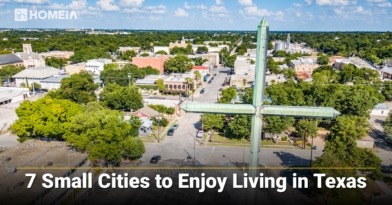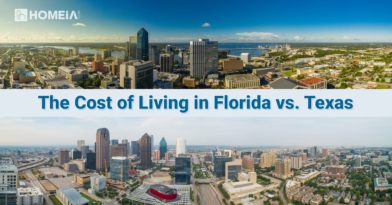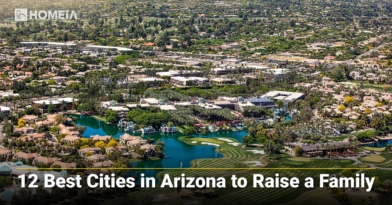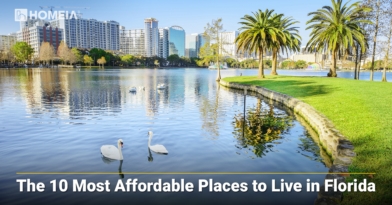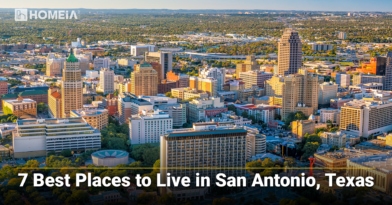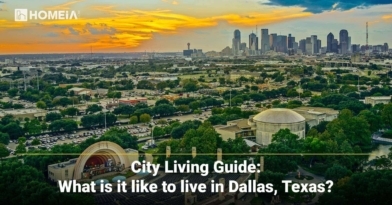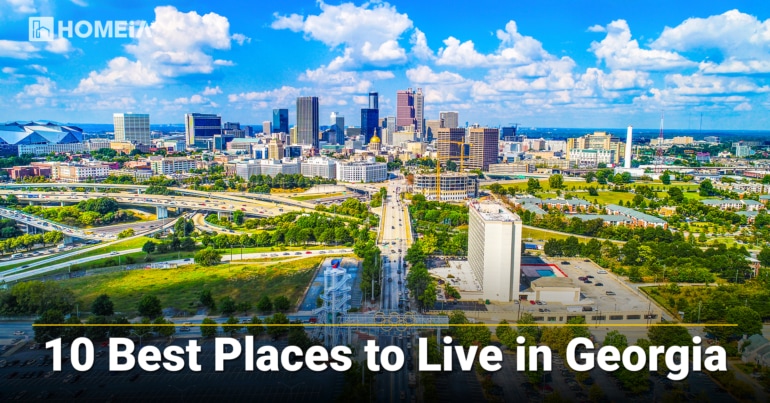5 Best Places to Live in Texas
- Author:by The HOMEiA Team
- Category: City Living Guide
The great state of Texas has something for everybody. Having lived there for 20-plus years, I can assure you that art and culture, vibrant industries and world-class universities are as much a part of The Lone Star State as are the images of rodeos, ten-gallon hats and country music.
The diversity of architecture, attitudes and cultures in different cities is extraordinary. Going from Dallas to Houston to San Antonio to Austin gives you intrinsically different vibes in terms of energy, culture and even politics.
For a decidedly red state, there are liberal enclaves all over — like the city of Austin and pockets in Houston, San Antonio and the Dallas-Fort Worth area.
Then there are the smaller cities, hidden gems like the towns in the Texas Hill Country, havens and getaways for those a bit weary of big city living.
We will be presenting Texas cities in two tiers. In Part I we will discuss the five largest cities by population. In Part II we will discuss smaller cities. Along the way, we will discuss many of the places that I have enjoyed visiting with friends and family over the years.
For each community, we assign the score, which provides an overall assessment of its safety and appeal as a place to call home.
Here’re the 5 best places to live in Texas.
Table of Contents:
1. Austin
HOMEiA Score: 96/100
- Population: 961,855 | Rank Last Year: #3
- Cost of Living: 29.4% above the national average
- Home price to income ratio: $337,400/$71,576 = 4.71 (buying homes is expensive)
- Income to rent ratio: $71,576/$15,360 = 4.66 (renting homes is affordable)
Austin is the capital of the state of Texas and the seat of Travis County, located 75 miles north of San Antonio and 195 miles south of Dallas along I-35. The Austin-Bergstrom International Airport serves the city.
U.S. News & World Report ranks Austin as #5 on its list of best cities to live in the U.S. and the #1 option within Texas. Austin is ranked #50 on the list of the best U.S. cities to retire to.
a. History, Size and Population
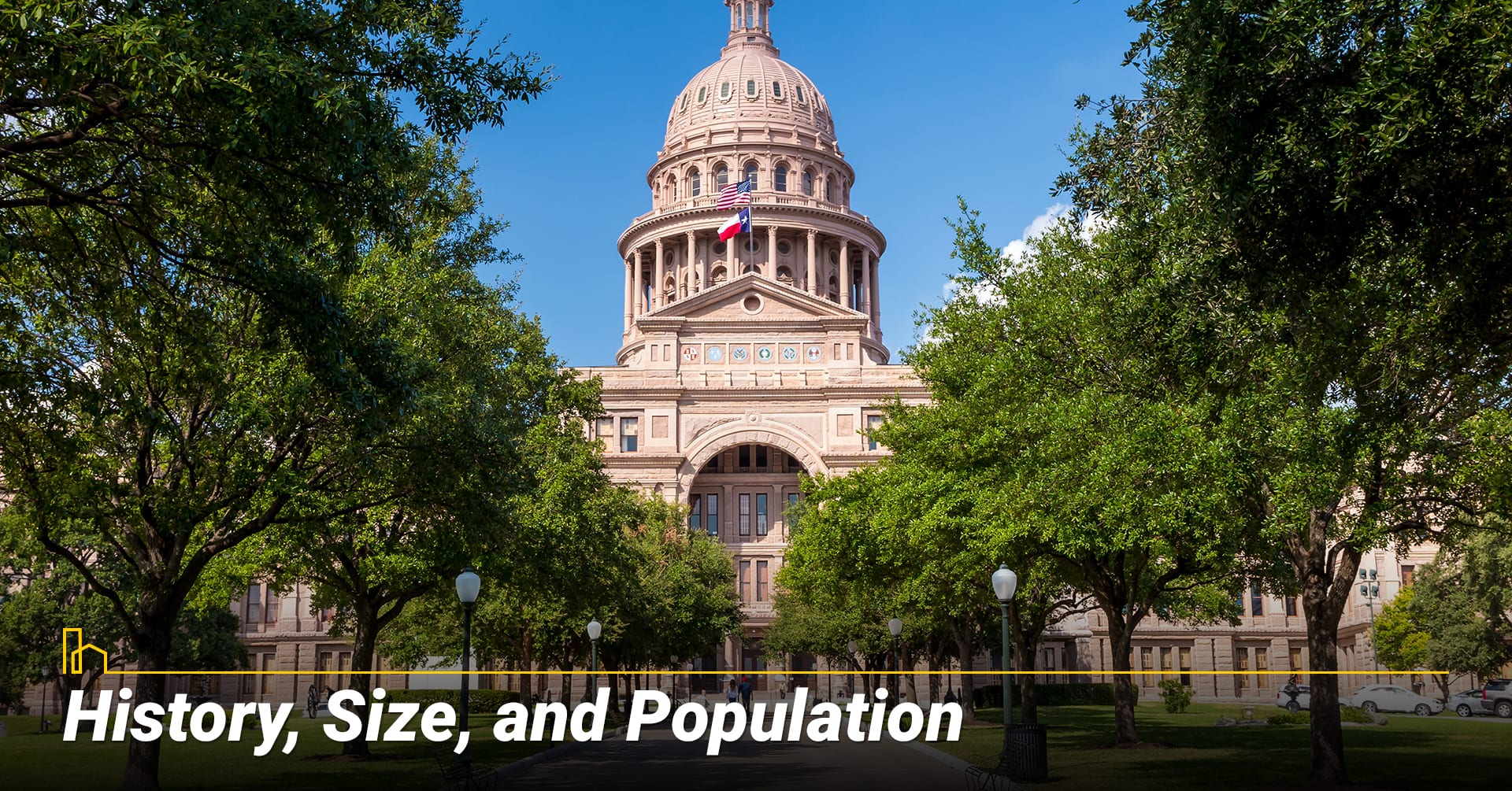
Austin was incorporated in 1839, built on a site called Waterloo in the middle of a buffalo hunting region. The site was renamed after the “Father of the Republic of Texas,” Stephen F. Austin, when it became the capital for a brief period. When Texas joined the American Union in 1845, Austin was again named as its capital after a four-year hiatus.
Austin is the fourth largest city in Texas and the 11th largest city in the U.S., with a population of 961,855 (2020 estimate) and a metro area population of 2.06 million spread over a 327-square-mile area. The population density is 3,229 per square mile (2020 estimate).
The population in Austin grew by 21.7% from April 2010 through 4/1/2020 (source: U.S. Census Quick Facts), above both the overall U.S. rate of 6.3% and the Texas rate of 15.3%.
b. Median Income, Cost of Living and Housing Market Characteristics
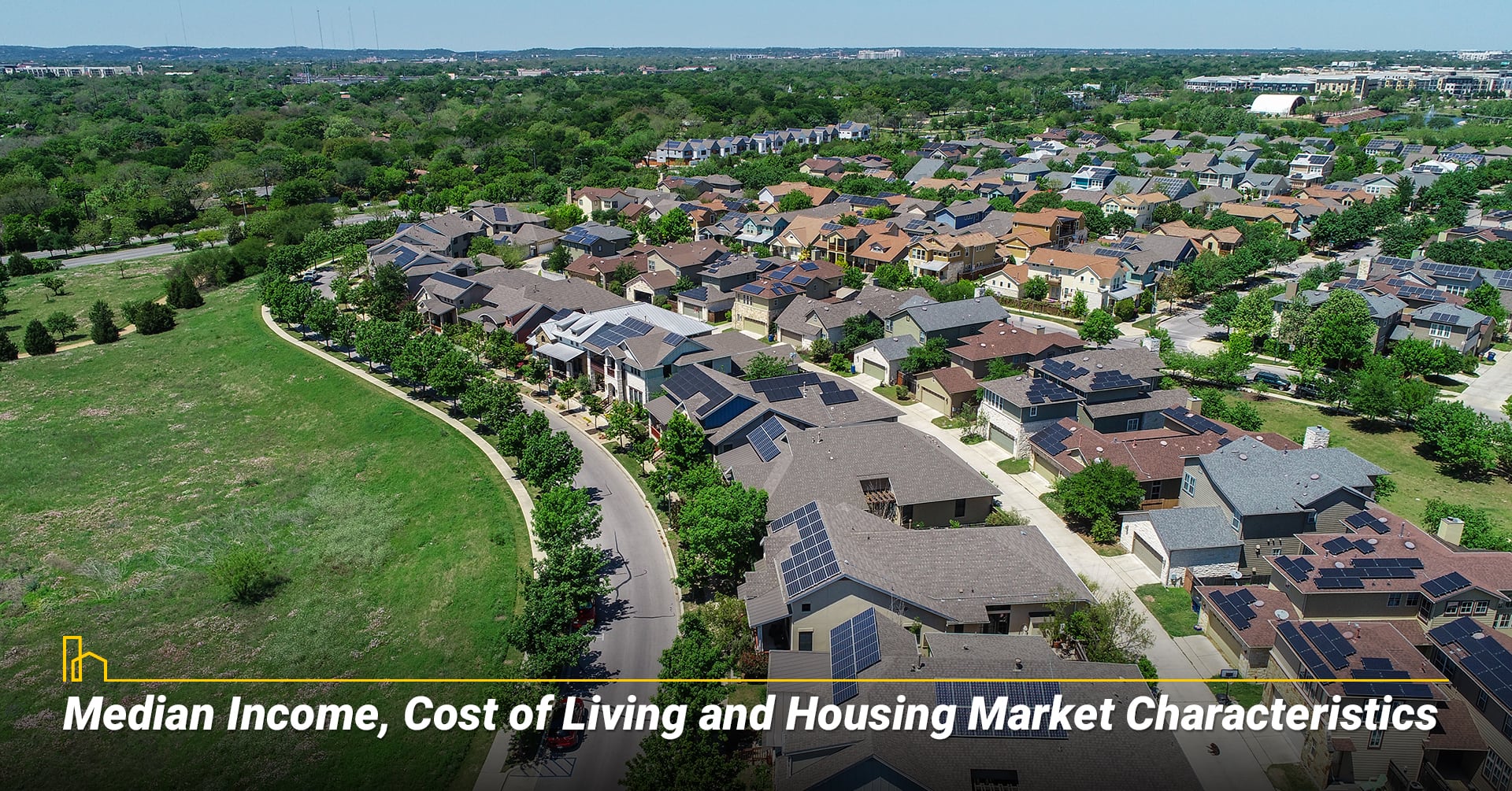
The numbers below show the median income, cost of living and the annual spending on housing for owned and rented properties in Austin.
AUSTIN MEDIAN HOUSEHOLD INCOME (2010-2020): $71,576
Austin Cost of Living
- 19% Above the U.S. National Average
- 17% Higher Than Dallas, Texas
- 22% Higher Than New York City, New York
- 12% Higher Than Chicago, Illinois
Austin Housing Costs
| Median Home Value | Annual Spend for Homeowners | Annual Spend for Renters (Rent & Utilities) |
| $337,400 | $24,372 | $15,360 |
Austin shows a home P/E (home price to income) ratio of 4.71, based on a median home value of $337,400 and a median household income of $71,576. The U.S. average is 3.5. Therefore, it is expensive to buy homes in the Austin area.
Austin shows an income to rent ratio of 4.66, based on a median household income of $71,576 and an annual spend of $15,360. Therefore, it is affordable to rent properties in Austin.
In Austin, 45.1% of residents own their homes.
15 Best Cities for Families in Texas
There are many employment opportunities throughout the state and many enjoyable communities to call home. We’ve compiled a list of 15 cities that rank high in education, affordability, and safety—areas of interest for many potential homeowners…
Top Neighborhoods in Austin, TX:
The list of best neighborhoods to live in has morphed significantly since the late 1990s, when the technology boom prompted an expansion of the city.
The following neighborhoods stand out:
- South Austin/South Lamar/South Congress (Home Value Range: $575,000 to $675,000)
The “in” neighborhood in the city, with bars, restaurants, art and music on display. - North Loop (Average Home Value Range: $475,000 to $520,000)
Contiguous with UT-Austin, this area combines bars, boutiques and cafes — a combination of the party life and the casual life. - Old West Austin (Home Value Range: $290,000 to $2.9 million)
This area mixes urban and rural living in a way that defines Austin. - Cherrywood, East and East-Central Austin (Median Home Value Range: $580,000 to $650,000)
Combines city, rural and college life. - Allandale (Median Home Value: $700,000)
This welcoming community next to Cherrywood features smaller homes interspersed with what is needed for laid-back city living, such as eateries and boutiques. - Mueller (Median Home Value $1 million)
Another area close to Allandale and Cherrywood, Mueller is a neighborhood built where the old airport used to be. It continues the laid-back tradition of Austin. - The Domain (Median Home Value: $370,000)
This is one of the newer neighborhoods born as a result of the tech boom. - Westlake Hills (Median Home Value: $1.6 million)
This higher-end suburb epitomizes the rustic charm of several decades ago.
c. Employment Prospects

The unemployment rate in Austin is 3.2% (June 2021), which is below both the U.S. national rate of 3.9% and the Texas rate of 5.0%. The poverty rate, at 13.2%, is above the national average of 10.5% but below the Texas average of 13.6%.
Austin is known as the technology hub of the U.S. South, with its large concentration of high-tech companies that have attracted young professionals and changed the city’s sleepy town reputation from the late 1990s onwards. Industries in the area include technology, instrumentation, bioengineering and other high-tech fields.
Noted companies that are headquartered in Austin include Whole Foods, National Instruments, Big Commerce, Silicon Labs, FacePoint and Cirrus Logic. Dell is headquartered nearby in Round Rock.
Other top employers in the area are the Texas state government and its vendors and affiliates, as well as the various departments and institutions within the University of Texas system.
The Austin area has an average commute time of 24.5 minutes.
d. Unique Attributes and Lifestyle
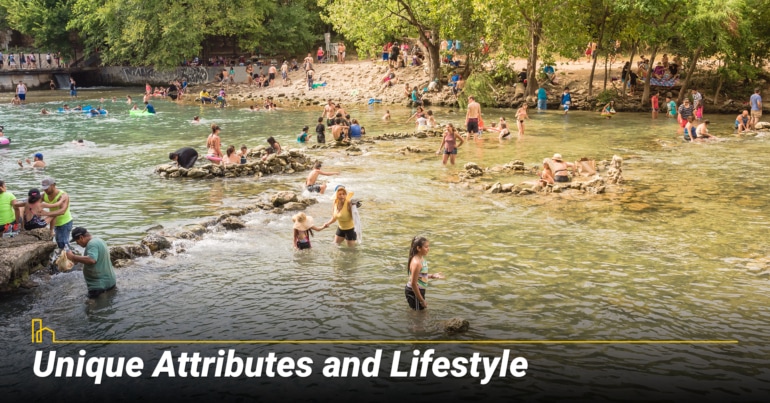
Austin is a town filled with young professionals and college students. It has been dubbed both the “Live Music Capital of the World” and the “Drunkest City in the U.S.”
“Keep Austin Weird” is a popular T-shirt slogan that embodies the bohemian spirit of the city. Austin is considered a haven for young professionals — a city that often defies the social conservativeness that is prevalent in the rest of the state.
Austin is known for many other things as well, including:
- Multiculturalism. Austin is known for its multicultural population. The city’s vibrant music, arts and cultural scene has gained national prominence and reinforces the reputation that Austin has developed in terms of embracing new visitors and citizens.
- Music and Culture. Austin welcomes any form of music, be it rock, blues, jazz, bluegrass, or country. The city’s musical tastes are highlighted in many places, from the live music at iconic Sixth Street spots to festivals such as the South by Southwest Music Festival.
- Texas Hill Country. Austin is close to the Texas Hill Country, a perfect getaway along a stretch that extends on either side of I-35 between Austin and San Antonio.
- Landscape and Natural Beauty. Austin, at the northern end of the hill country, on the Colorado River, displays undulating landscapes and vistas that continue to impress residents and visitors. Spots such as Mount Bonnell, Zilker Park and the Balcones Canyonland Preserve are favorites for nature lovers, hikers and campers. Within city limits lies the Ladybird Johnson Wildflower Center.
e. Education
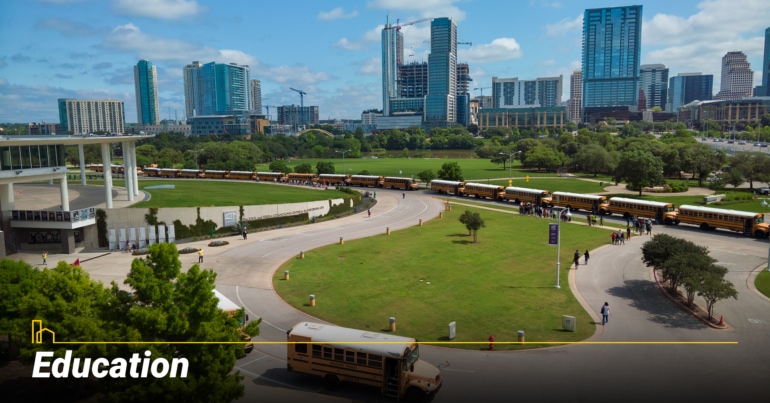
Austin is home to six recognized universities and colleges. The best-known one is the University of Texas at Austin, ranked #29 nationally by U.S. News & World Report.
The Austin Independent School District serves about 74,000 students across 125 schools. According to U.S. News & World Report, the Austin metro area has a total of 94 public and 113 private schools, and 54 of its high schools are ranked nationally.
Overall, the Austin area is known for good educational infrastructure, ahead of the average for similarly sized metro areas.
f. Healthcare and Safety

While none of Austin’s hospitals are nationally ranked in specific medical specialties, there are strong regional presences by the Ascension Seton group of hospitals in multiple locations. St. David’s Medical Center is generally considered to be the top facility in Austin.
Austin has 4.88 violent crimes per 1,000 residents, below Texas’s statewide median rate of 4.50 and just above the U.S. national median rate of 4.00. It has 38.04 property crimes per 1,000 residents, above Texas’s statewide median of 22.62 and the U.S. national median of 19.00.
Recommended for you
2. Dallas
HOMEiA Score: 90/100
- Population: 1,304,379 | Rank Last Year: #2
- Cost of Living: 1.0% above the national average
- Home price to income ratio: $188,100/$52,580 = 3.58 (buying homes is affordable)
- Income to rent ratio: $52,580/$12,624 = 4.17 (renting homes is affordable)
Dallas is located in north central Texas, approximately 30 miles to the east of Fort Worth. The Dallas-Fort Worth area is served by the east/west freeway I-20, which becomes I-30 just west of Fort Worth. The main north/south freeway is I-75, which ends in downtown Dallas and becomes I-45 going southeast to Houston. I-35 is another freeway through the area.
The major airport serving Dallas is the Dallas-Fort Worth International Airport.
U.S. News & World Report ranks the Dallas-Fort Worth combined area #37 on its list of best cities to live in the U.S., and the #2 option within Texas. The area is ranked #75 on the list of the best U.S. cities to retire to.
a. History, Size and Population
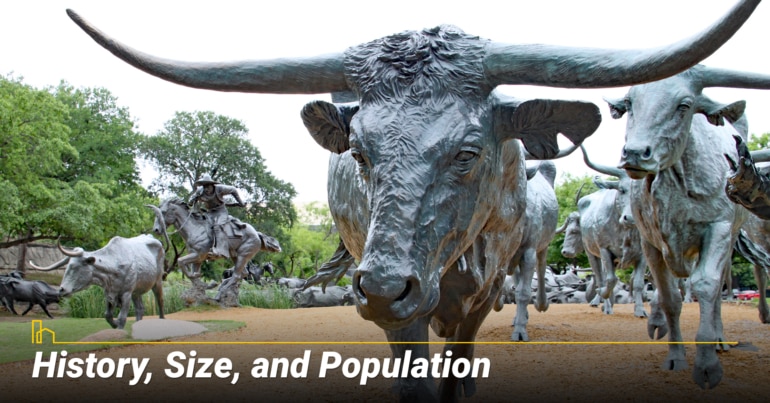
Dallas originally had a native Caddo population. The area was then successively occupied by France, Spain and Mexico before becoming part of the Republic of Texas and then the U.S. The city of Dallas was incorporated in 1856.
Dallas is the third-largest city in Texas and the ninth-largest city in the U.S., with a population of 1,304,379 (2020 estimate) spread over a 383-square-mile area. The population density is 3,831 per square mile (2020 estimate).
The population in Dallas grew by 8.9% from April 2010 through 4/1/2020 (source: U.S. Census Quick Facts), above the overall U.S. rate of 6.3% but below the Texas rate of 15.3%..
The Dallas-Fort Worth combined metro area has a population of 7.26 million. Dallas is the largest city, population-wise, among the Dallas-Fort Worth-Arlington tri-city area.
b. Median Income, Cost of Living and Housing Market Characteristics

The numbers below show the median income, cost of living, and the annual spending on housing for owned and rented properties in Dallas.
DALLAS MEDIAN HOUSEHOLD INCOME (2010-2020): $52,580
Dallas Cost of Living
- 2% Above U.S. National Average
- 15% Lower Than Austin, Texas
- 6% Lower Than New York City, New York
- 4% Lower Than Chicago, Illinois
Dallas Housing Costs
| Median Home Value | Annual Spend for Homeowners | Annual Spend (Rent & Utilities) |
| $188,100 | $20,124 | $12,624 |
Dallas shows a home P/E (home price to income) ratio of 3.58, based on a median home value $188,100 and a median household income of $52,580. The U.S. average is 3.5. Therefore, it is affordable to buy homes in the Dallas area.
Dallas shows an income to rent ratio of 4.17, based on a median household income of $52,580 and an annual spend of $12,624. Therefore, it is also affordable to rent properties.
Thirty one percent of owners in Dallas are housing cost burdened, which is just above the U.S. nationwide rate of 30.2%. This shows housing is affordable for less residents of Dallas than in the U.S. overall.
In Dallas, 40.9% of residents own their homes.
7 Best Small Towns to Live in Texas
We present 7 smaller cities that are great for professionals, retirees, and families with children. Incidentally, they also happen to be places that I have enjoyed visiting with family and friends over the decades. In our examination, we’ll prioritize things that may be more important for families who prefer not to live in heavily urbanized areas…
Top Neighborhoods in Dallas, TX:
The best neighborhoods to live in are spread around Dallas and Collins Counties, including nearby places like Richardson, Plano and Irving:
- Cotton Creek South (Median Home Value: $329,000) and Canyon Creek North (median home value $348,000)
Described as “sparse urban,” these contiguous neighborhoods in Richardson are rated as two of the best, with Canyon Creek South holding the top place. Known for their excellent schools, these areas are also home to many parks, coffee shops and restaurants. - Canyon Creek South (Median Home Value: $413,000) and Heights Park (median home value $289,000)
Also in Richardson, the Canyon Creek South and Heights Park neighborhoods are characterized as “sparse suburban,” with a significantly higher percentage of owner-occupied homes than rentals. Like Cotton Creek South above, they are known for excellent schools as well as the relaxed ambience of the suburbs. - Timberbrook (Median Home Value: $327,000)
Another excellent neighborhood in the Dallas area, Timberbrook is also known for great public schools, casual and formal dining spots and parks and recreation areas nestled in between a more densely packed suburb. - Preston Highlands (Median Home Value: $383,000)
Within Dallas proper, this neighborhood exhibits reasonableness all around, from home prices to political views. The area is known for an influx of young professionals, who tend to rent more often. Food, entertainment and schools are of high quality. - Douglas Community (Median Home Value: $130,000)
This is a lower-priced neighborhood with an urban and suburban mix of amenities. The area features more rentals than owner-occupied houses but has access to excellent schools. - Greenwood Hills (Median Home Value: $238,000)
This is a moderately priced neighborhood with an even mix of owner-occupied and rental housing and great schools.
c. Employment Prospects
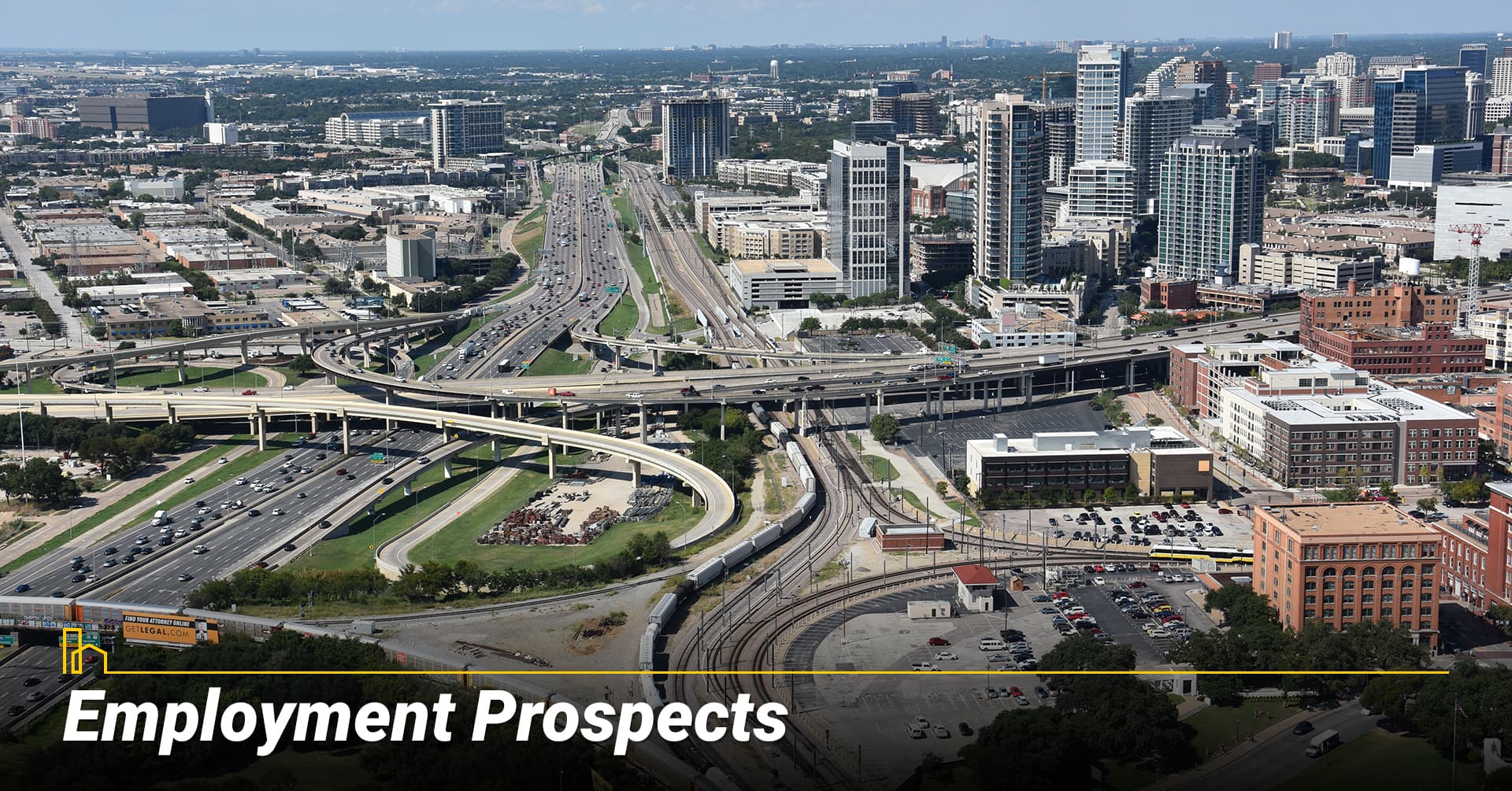
The unemployment rate in Dallas is 3.9% (June 2021), which is below both the U.S. national rate of 3.9% and the Texas rate of 5.0%. The poverty rate, at 18.9%, is above the national average of 10.5% and the Texas average of 13.6%.
Dallas went through multiple boom periods, first as a manufacturing hub for the U.S. Armed Forces during WWII, and later, from the oil and natural gas industry. Today, it is a diversified economy with a strong focus on services and technology.
In the Dallas area, the top industries are technology, financial services and defense. There are a number of financial, business and educational jobs in the Dallas-Fort Worth area, along with service economy jobs such as retail/sales, nursing, engineering, medicine and accounting. There are a number of start-ups that provide jobs for tech consultants.
Noted companies that are headquartered in and around Dallas include Southwest Airlines, AT&T, CBRE, Texas Instruments and Dean Foods. Some other companies have their headquarters located in nearby cities, including Toyota’s U.S. Headquarters (Plano), Fluor Corporation (Irving) and Texas Health Resources (Arlington).
Dallas residents have an average commute time of 27.1 minutes.
d. Unique Attributes and Lifestyle

Dallas is a cosmopolitan city with a diversified economy, with a population that has grown younger, even though it is still considered a great place to retire.
The memory of the John F. Kennedy assassination is forever linked with Dallas, which is why there are multiple areas paying homage to the late President. The John F. Kennedy Memorial Plaza downtown, the historic Dealey Plaza (where President Kennedy was assassinated) and the Sixth Floor Museum (located in the former Texas School Book Depository, from which Lee Harvey Oswald fired the fatal bullets) are all stops for the history buffs.
Dallas is known for many other things as well, including:
- Museums, Art and Culture. The Bishop Arts District is a well-known area for browsing bookstores, looking at artwork and nibbling at cafes. For more arts and culture, head over to neighboring Fort Worth for a plethora of museums and cultural venues.
- Live Entertainment and Fine Dining. There are multiple entertainment and dining districts spread around Dallas, the two most prominent being the Deep Ellum Entertainment District and the great eating establishments at Stone Street Gardens downtown.
- Major League Sports. The city hosts the Dallas Mavericks of the NBA and the Dallas Stars of the NHL. The Texas Rangers and the Dallas Cowboys play baseball and football, respectively, in nearby Arlington.
- Family Activities. Whether it’s Six Flags over Texas, the Dallas Arboretum and Botanical Gardens, the Dallas World Aquarium, or catching a sunset from atop Reunion Tower, there is plenty of family fun to be had around Dallas.
e. Education
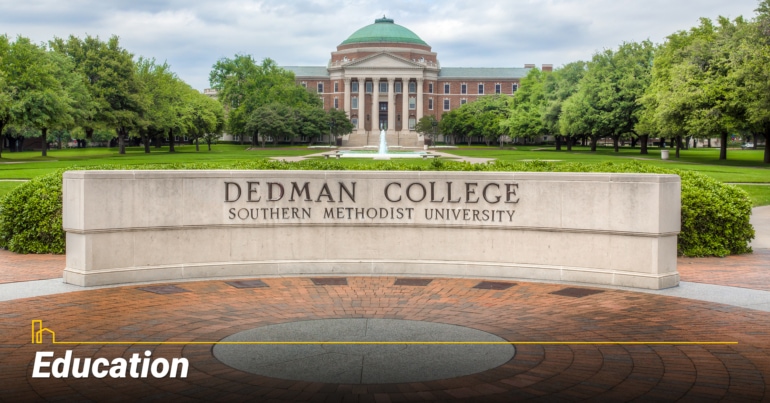
The Dallas-Fort Worth area is home to 18 recognized universities. The well-known ones in Dallas include Southern Methodist University, the University of Dallas, University of North Texas and the University of Texas at Dallas. Four of the universities are nationally ranked by U.S. News & World Report, the top one being SMU at #66 nationally.
The Dallas Independent School District serves about 154,000 students across 230 schools. Per U.S. News & World Report, the Dallas-Fort Worth metro area has a total of 355 public and 401 private schools, and 214 of its high schools are ranked nationally.
Overall, the DFW area is known for good educational infrastructure, ahead of the average for similarly sized metro areas.
f. Healthcare and Safety
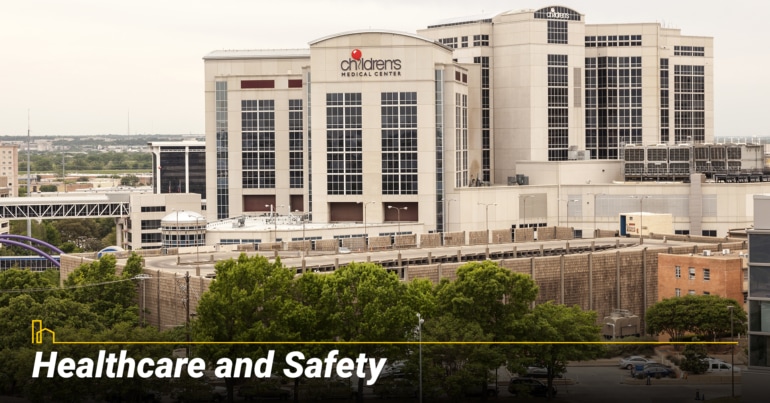
Dallas boasts a number of hospitals that are nationally ranked in specific medical specialties, including the UT Southwestern Medical Center, Baylor University Medical Center and the Parkland Health and Hospital System-Dallas.
Dallas has 8.84 violent crimes per 1,000 residents, above Texas’s statewide median rate of 4.19 and the U.S. national median rate of 4.00. It has 34.39 property crimes per 1,000 residents, above Texas’s statewide median of 23.91 and the U.S. national median of 21.00.
Recommended for you
3. Fort Worth
HOMEiA Score: 88/100
- Population: 918,915 | Rank Last Year: #3
- Cost of Living: 0.2% above the national average
- Home price to income ratio: $169,700/$62,187 = 2.73 (buying homes is affordable)
- Income to rent ratio: $62,187/$12,720 = 4.89 (renting homes is affordable)
Fort Worth is one of the best & affordable places to live in texas for families. Fort Worth is located in north central Texas, approximately 30 miles to the west of Dallas. The Dallas-Fort Worth area is served by the east/west freeway I-20, which becomes I-30 just west of Fort Worth. The main north/south freeway is I-75, which ends in downtown Dallas and becomes I-45 going southeast to Houston. I-35 is another freeway through the area.
The major airport serving Fort Worth is the Dallas-Fort Worth International Airport.
U.S. News & World Report ranks the Dallas-Fort Worth combined area #37 on its list of best cities to live in the U.S., and the #2 option within Texas. The area is ranked #75 on the list of the best U.S. cities to retire to.
a. History, Size and Population

Fort Worth was incorporated in 1849 on the Trinity River. It was the last of a string of forts that were built to protect a large number of trading posts. The garrisons protected the commerce associated with western migrations, earning the city its nickname of “Where the West Begins.”
Fort Worth is the 5th largest city in Texas, with a population of 918,915 (2020 estimate) spread over 356-square-mile area. The population density is 2,704 per square mile (2020 estimate).
Over 2000 to 2006, Fort Worth was the fastest-growing city in the U.S. The population in Fort Worth grew by 24.0% over April 2010 and 4/1/2020 (source: U.S. Census Quick Facts), above both the overall U.S. rate of 6.3% and the Texas rate of 15.3%.
The Dallas-Fort Worth combined metro area has a population of 7.26 million.
b. Median Income, Cost of Living and Housing Market Characteristics
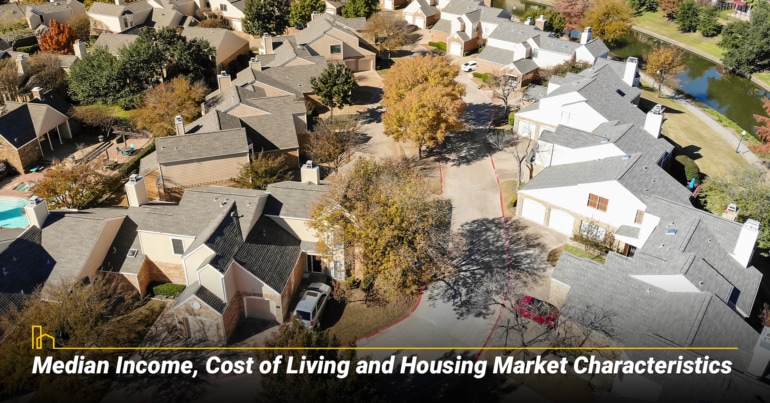
The numbers below show the median income, cost of living and the annual spending on housing for owned and rented properties in Fort Worth.
FORT WORTH MEDIAN HOUSEHOLD INCOME (2010-2020):$62,187
Fort Worth Cost of Living
- 0.2% Below U.S. National Average
- 16% Lower Than Austin, Texas
- 7% Lower Than New York City, New York
- 7% Lower Than Chicago, Illinois
Fort Worth Housing Costs
| Median Home Value | Annual Spend for Homeowners | Annual Spend (Rent & Utilities) |
| $169,700 | $19,080 | $12,720 |
Fort Worth shows a home P/E (home price to income) ratio of 2.73, based on a median home value of $169,700 and a median household income of $62,187. The U.S. average is 3.5. Therefore, it is very affordable to buy homes in the Fort Worth area.
Fort Worth shows an income to rent ratio of 4.89, based on a median household income of $62,187 and an annual spend of $12,720. Therefore, it is affordable to rent properties.
In Fort Worth, 57.4% of residents own their homes.
The Cost of Living in Florida vs. Texas
Texas and Florida are vast and have hundreds of communities to choose from. But what are the pros and cons of living in each state? Come with HOMEiA as we explore 7 crucial factors that reveal the true costs of choosing Florida or Texas as your new home…
Top Neighborhoods in Fort Worth, TX:
Fort Worth has many neighborhoods that feature wide-open spaces and large houses. There are also multiple mixed communities for young millennials in the area.
Many neighborhoods in the Fort Worth area display a wide range of prices due to the mix of the types of properties and the residents.
- Austin Heights (Home Value Range: $110,000 to $1.8 million)
Just north of I-30 and next to the Cultural District, this neighborhood offers a mix of homes suitable for both families and young millennials. It is quieter than being in the middle of the city, but within reach of everything. - Rivercrest (Home Value Range $330,000 to $5 million)
A quiet suburb with great views from Crestline Road next to the river; the large homes in this historic district are highly priced. The Rivercrest Country Club adds to the property values. - Fairmount (Home Value Range: $200,000 to $500,000)
The largest historical district in the southwest, Fairmount abuts Magnolia Avenue, which means there is plenty to do. Homes vary in size. Families love Fairmount due to the abundant parks and excellent school system. - Westover Hills (Home Value Range: $1 million and up)
This exclusive community next to the Cultural and River Districts features fewer than 800 single-family homes with large lots. - Westcliff (Home Value Range $200,000 to $2 million)
Next to the beautiful campus of Texas Christian University, Westcliff has grown from a sleepy student town to a much more diverse community, as is reflected in the range of home prices. There is something for every budget in Westcliff, and an excellent public school adds to its appeal.
c. Employment Prospects
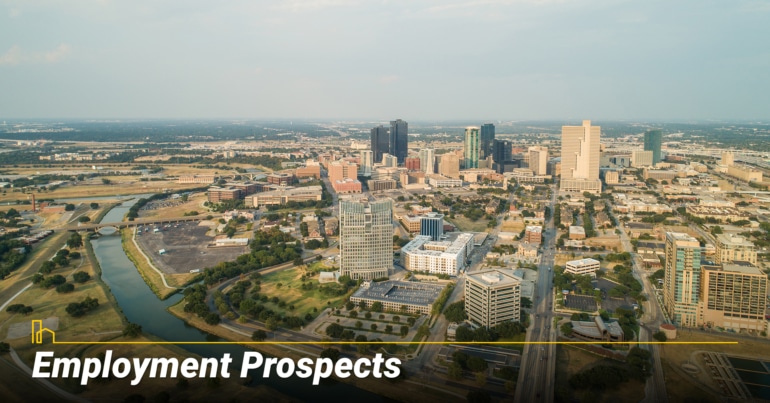
The unemployment rate in Fort Worth is 3.9% (June 2021), which is below both the U.S. national rate of 3.9% and the Texas rate of 5.0%. The poverty rate, at 14.5%, is above the national average of 10.5% and the Texas average of 13.6%.
In its early days, Fort Worth was known as a cattle and goods trading post with a crucial railhead, a far cry from the modern metropolis it is today. Its explosive growth came mainly due to its oil and natural gas reserves, which made it a boom town over the past 40 years.
In the Fort Worth area, the major industries these days are oil and gas, manufacturing, aviation and aerospace. There are many financial, business and educational jobs in the Dallas-Fort Worth area, along with service economy jobs such as retail and sales, nursing, engineering, medicine and accounting. There are a number of start-ups that provide jobs for tech consultants.
Noted companies that are headquartered in or around Fort Worth include the American Airlines Group, GM Financial, Ben E. Keith Company and Lockheed Martin.
The Fort Worth area has an average commute time of 27.2 minutes.
d. Unique Attributes and Lifestyle
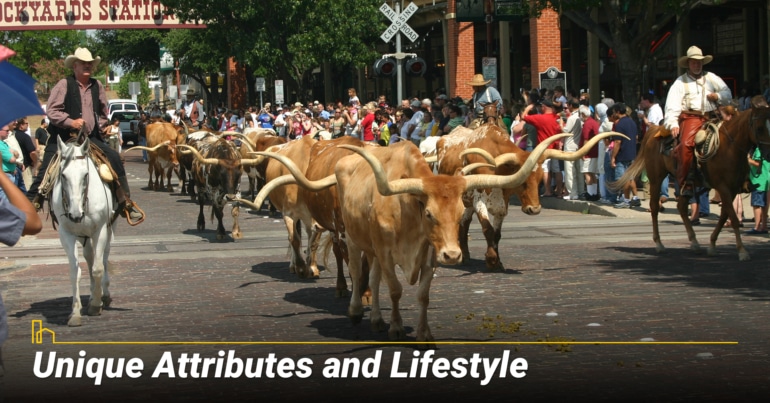
Coming from a culture of trading posts and embattlements, Fort Worth mixes in the Wild West culture with a dizzying array of museums and performance halls. It is known as the cultural capital of north central Texas, with several places for history and culture buffs to enjoy:
- Fort Worth Stockyards. Established in 1866, the historic Stockyards Museum and the nearly 100-acre district surrounding it remind visitors of the days of the old cattle roundups and drives, and how Fort Worth grew around those activities.
- Museums, museums and more museums. Fort Worth has many museums for art and culture lovers of all ages, including the Amon Carter Museum of American Art, the Kimbell Art Museum, the Sid Richardson Museum, the Modern Art Museum of Fort Worth, the National Cowgirl Museum, the Texas Cowboy Hall of Fame, the Vintage Flying Museum, and the Fort Worth Museum of Science and History.
- Sundance Square Plaza, Bess Performance Hall and Circle Theater. Named after the Sundance Kid, this downtown district combines shopping, dining and cultural activities.
- Natural Parks. Natural and zoological attractions in Fort Worth include the Fort Worth Botanic Gardens, the Fort Worth Natural Gardens and the Fort Worth Zoo.
e. Education

The Dallas-Fort Worth Area is home to 18 recognized universities. The well-known ones in Fort Worth include Texas Christian University and Texas Wesleyan University. Four of the universities in the DFW area are nationally ranked by the U.S. News & World Report.
The Fort Worth Independent School District serves about 84,000 students across 143 schools. According to U.S. News & World Report, the Dallas-Fort Worth metro area has a total of 355 public and 401 private schools, and 214 of its high schools are ranked nationally.
Overall, the DFW area is known for good educational infrastructure, ahead of the average for similarly sized metro areas.
f. Healthcare and Safety
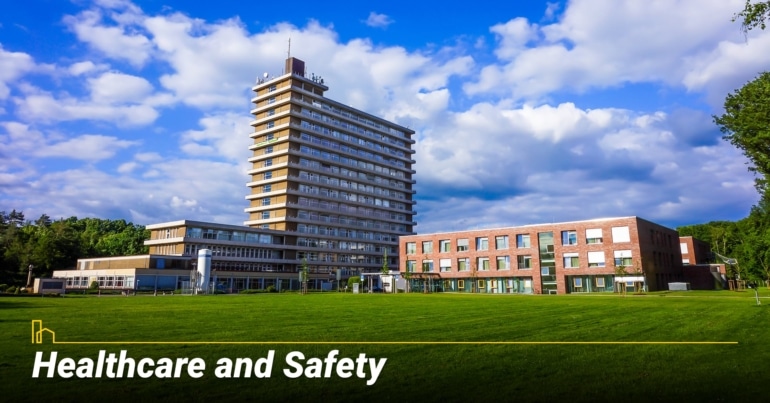
Fort Worth residents have access to all of the medical facilities in Dallas. While there are no medical centers in Fort Worth proper that are nationally ranked in any specific category, the top hospitals include Texas Health Harris Medical Center (Southwest and Fort Worth campuses) and Baylor Scott and White Medical Center-Fort Worth.
Fort Worth has 5,47 violent crimes per 1,000 residents, just above Texas’s statewide median rate of 4.19 and the U.S. national median rate of 4.00. It has 27.18 property crimes per 1,000 residents, above Texas’s statewide median of 23.91 and the U.S. national median of 21.00.
Recommended for you
4. Houston
HOMEiA Score: 88/100
- Population: 2,304,580 | Rank Last Year: #4
- Cost of Living: 4.5% above the national average
- Home price to income ratio: $171,800/$52,338 = 3.28 (buying homes is affordable)
- Income to rent ratio: $52,338/$12,492 = 4.19 (renting homes is affordable)
Located in southeast Texas, Houston is 50 miles northwest of Galveston Bay on the Gulf of Mexico, sitting at the juncture of I-10 going east/west, and I-45 and I-69 (formerly US-59) going north/south. There are two major airports, George Bush International and Houston Hobby.
U.S. News & World Report ranks Houston as #39 on its list of best cities to live in the U.S. and the #3 option within Texas. It is ranked #93 on the list of the best U.S. cities to retire to.
a. History, Size and Population
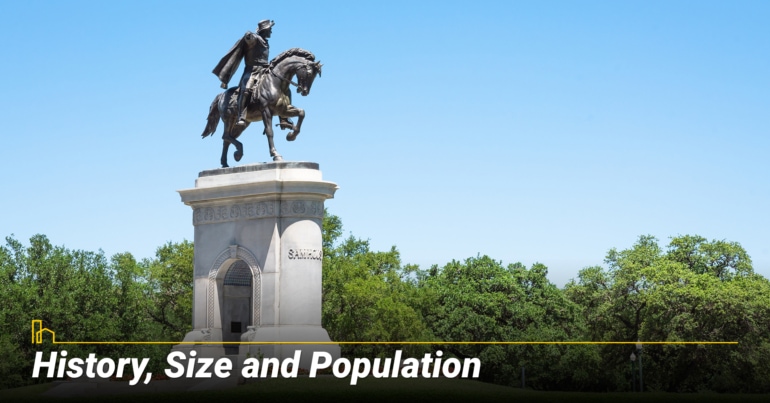
Houston, founded in 1837, was named after Samuel Houston, the war hero who won decisively over the Mexican General Santa Anna at the Battle of San Jacinto on April 21, 1836.
Houston is the largest city in Texas and the fourth-largest city in the U.S., with a population of 2,304,580 (2020). The only un-zoned major U.S. city, Houston has an area of 672 square miles. The population density is 3,844 per square mile (2020).
The population in Houston grew by 9.8% from April 2010 through 4/1/2020 (source: U.S. Census Quick Facts), above the overall U.S. rate of 6.3% but below the Texas rate of 15.3%.
The Houston metro area population is much larger at approximately 6.78 million.
b. Median Income, Cost of Living and Housing Market Characteristics

The numbers below show the median income, cost of living and the annual spending on housing for owned and rented properties in Houston.
HOUSTON MEDIAN HOUSEHOLD INCOME (2010-2020): $52,338
Houston Cost of Living
- 4% Below U.S. National Average
- 19% Lower Than Austin, Texas
- 12% Lower Than New York City, New York
- 10% Lower Than Chicago, Illinois
Houston Housing Costs
| Median Home Value | Annual Spend for Homeowners | Annual Spend (Rent & Utilities) |
| $171,800 | $19,752 | $12,492 |
Houston shows a home P/E (home price to income) ratio of 3.28, based on a median home value of $171,800 and a median household income of $52,338. The U.S. average is 3.5. Therefore, it is affordable to buy homes in the Houston area.
Houston shows an income to rent ratio of 4.19, based on a median household income of $52,338 and an annual spend of $12,492. Therefore, it is affordable to rent properties in Houston.
In Houston, 42.3% of residents own their home.
12 Best Cities to Live in Arizona for Families
We took 4 main variables into consideration to determine the best places in Arizona to raise a family. The variables are quality of education, health care, personal safety, and recreational opportunities. Here you’ll find our list, along with the highlights that make each Arizona locale a special place to raise a family…
Top Neighborhoods in Houston, TX:
The best neighborhoods to live in often depend on work commute and school districts, but in general, the following neighborhoods stand out within Houston:
- West University Place (Average Home Value: $2.2 million)
Next to Rice University, the Texas Medical Center and the Museum District, this neighborhood was rated as the best “city” to live in the U.S. by Wall Street 24/7 in 2018 and 2019. - River Oaks (Average Home Value: $2.2 million)
The original area where the rich lived in Houston, River Oaks is also home to entertainment, cultural and shopping venues. - Tanglewood (Average Home Value: $1.6 million)
A woodsy enclave just outside the inner loop, with the ability to spread out and experience a hint of country living. - The Museum District (Average Home Value: $1.2 million)
Ideal for art and culture lovers, with 19 museums, the Rothko Chapel and Hermann Park. - Bellaire (Average Home Value: $953,490)
Close to downtown amenities, such as the Galleria, but offers bigger homes at a reasonable price. - The Heights (Average Home Value: $813,899)
Historic landmark district. - Memorial (Average Home Value: $497,000)
Nestled within parks, great schools. - Spring Branch (Average Home Value: $462,000)
Large lot sizes at reasonable prices.
c. Employment Prospects
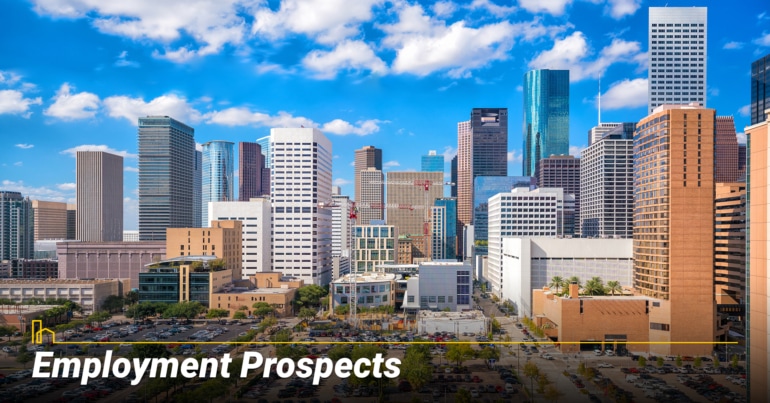
The unemployment rate in Houston is 3.9% (June 2021), which is above both the U.S. national rate of 5.1% and the Texas rate of 5.0%. The poverty rate, at 20.1%, is above the national average of 10.5% and the Texas average of 13.6%.
Houston has a cosmopolitan population, with many high-income earners ($200,000 and above) in industries such as oilfield services, aeronautics and medical sciences.
Houston has been ranked among the very top manufacturing metro areas in the U.S. It is home to almost two dozen Fortune 500 companies, including Sysco, FMC Technologies, Halliburton, KBR, Baker Hughes, ExxonMobil, Center Point Energy, Marathon Oil and Waste Management.
The Texas Medical Center and NASA’s Johnson Space Center are major employers in the area, along with retail, professional services and the accommodation and food services industries.
Houston residents have an average commute time of 27.7 minutes.
d. Unique Attributes and Lifestyle
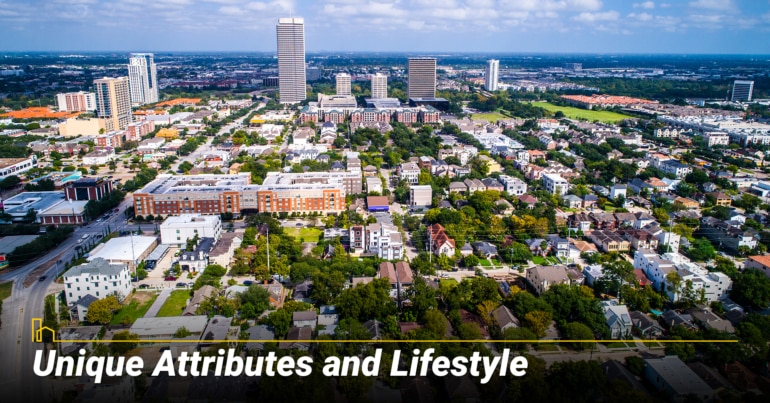
Houstonians are said to eat out more often than people in any other city — not a surprise given that the city has more than 10,000 restaurants, great bars, microbreweries, and music clubs. Try the world-famous Texas BBQ or some great Tex-Mex!
Besides food, Houston is known for many things, including:
- Art and Culture. The Museum District, with 19 museums, is a major attraction close to downtown and the Hermann Park area. Houston is also the place to see the Texas Renaissance Festival (pushing its 50th anniversary), the Houston Art Car Parade (hosted by The Orange Show) and uniquely Texan sites such as the Beer Can House.
- Music and Entertainment. The Theater District and the Houston Opera offer a great selection of music, as do the many musical venues across the city, such as the Ready Room in The Heights. Houston also has a thriving pub culture. The local Saint Arnolds brewery has become prominent, along with eclectic holes-in-the-wall such as Valhalla on the Rice University Campus.
- Shopping. Houstonians love to shop, whether it be at the Galleria in midtown, or at large malls such as Sharpstown and Woodlands.
- Parks and Recreation. Houstonians love long bike rides along the Buffalo Bayou, which bisects the city, or outdoor activity at spots like Hermann Park or Memorial Park.
- Professional Sports. Three major league teams — the Houston Rockets (NBA), Astros (MLB) and Texans (NFL) — have arenas in downtown Houston.
- The Houston Livestock Show and Rodeo. The Annual Houston Livestock Show and Rodeo, the largest such show in the world, draws tens of thousands of visitors every summer.
- Galveston Bay Area. The Galveston beachfront is an hour away from Houston. On the way, one can visit the Kemah Boardwalk and Moody Gardens. You will find something for all ages among nature preserves, family entertainment and fine dining options.
You will definitely need a car to drive around Houston, though public transportation has improved in some areas, especially along Main Street between downtown and the Texas Medical Center area.
e. Education

Houston is home to 13 recognized colleges and universities, including two that are nationally ranked. The top-ranked university in Texas, Rice University, is ranked #16 nationally by U.S. News & World Report. Other prominent universities in the area include the University of Houston, Houston Baptist University, University of St. Thomas and Texas Southern University.
The Houston Independent School District is the largest in Texas, and the 7th largest in the United States, serving about 200,000 students across 276 schools. According to U.S. News & World Report, the Houston metro area has a total of 247 public and 382 private schools, and 162 of its high schools are ranked nationally.
Overall, Houston has a decent educational infrastructure, on par with the average for similarly sized metro areas.
f. Healthcare and Safety
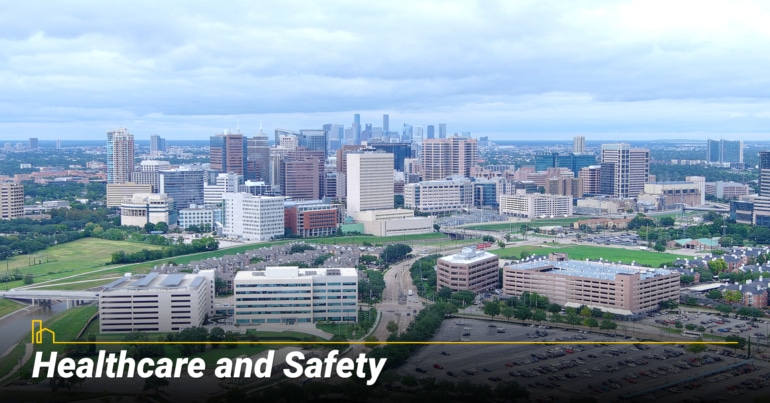
One of the biggest attractions to Houston residents is the Texas Medical Center, with its medical care and research facilities. Located along and around North Main Street, the center has more than 50 individual hospitals and research institutes. There are many outstanding hospitals, such as Texas Children’s Hospital, which is ranked #4 nationwide by U.S. News & World Report.
Other well-known medical establishments include the Houston Methodist Hospital, Baylor St. Luke’s Medical Center and the Memorial Hermann Texas Medical Center, all nationally ranked in specific medical specialties. There are a number of other hospitals that are highly ranked regionally, including the Houston Methodist San Antonio Hospital and various campuses under Memorial Hermann.
Houston has 12.82 violent crimes per 1,000 residents, above Texas’s statewide median rate of 4.19 and the U.S. national median rate of 4.00. It has 44.65 property crimes per 1,000 residents, above Texas’s statewide median of 23.91 and the U.S. national median of 21.00.
10 Most Affordable Places to Live in Florida in 2024
With year-round warm weather and over 8,000 miles of coastline, it’s no wonder Florida is a prime vacation destination. Filled with wildlife, beaches, lakes, rivers, amusement parks, diverse entertainment options and much more, the population of Florida is growing with people that want to call Florida “home,” soak up the sun…
5. San Antonio
HOMEiA Score: 83/100
- Population: 1,434,625 | Rank Last Year: #5
- Cost of Living: 10.2% above the national average
- Home price to income ratio: $146,400/$52,455 = 2.79 (buying homes is affordable)
- Income to rent ratio: $52,455/$11,904 = 4.41 (renting homes is affordable)
San Antonio is located 75 miles south of Austin along I-35 and 189 miles west of Houston along I-10. It is situated along the Balcones Escarpment at the headwaters of the San Antonio River. San Antonio International Airport serves the city.
U.S. News & World Report ranks San Antonio as #75 on its list of best cities to live in the U.S. and the #4 option within Texas. It is ranked #73 on the list of the best U.S. cities to retire to.
a. History, Size and Population
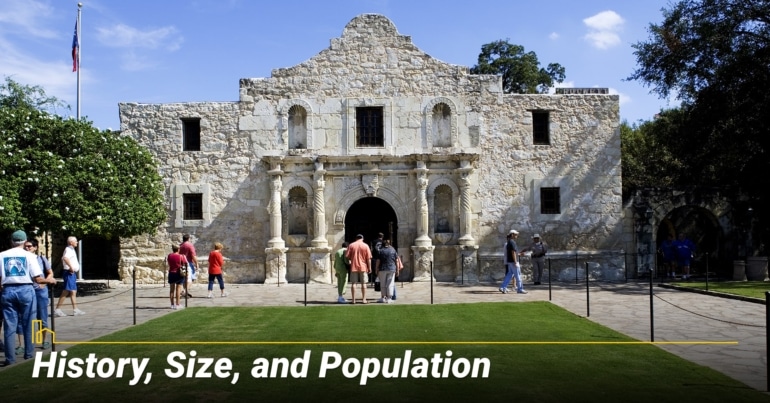
The Mission San Antonio de Valero, established in 1718, became known as the Alamo as a part of the Presidio (military garrison) within San Antonio de Bexar. The provincial capital was renamed as San Antonio after Texas gained independence from Mexico.
San Antonio is the second largest city in Texas and the fifth largest city in the U.S., with a population of 1,434,625 (2020 estimate) spread over 505 square miles. The population density is 3,112 per square mile (2020 estimate).
The population in San Antonio grew by 8.1% from April 2010 through 4/1/2020 (source: U.S. Census Quick Facts), above both the overall U.S. rate of 6.3% and the Texas rate of 15.3%.
The San Antonio Metro area population is 2.43 million.
b. Median Income, Cost of Living and Housing Market Characteristics

The numbers below show the median income, cost of living and the annual spending on housing for owned and rented properties in San Antonio.
SAN ANTONIO MEDIAN HOUSEHOLD INCOME (2010-2020): $52,455
San Antonio Cost of Living
- 10% Below U.S. National Average
- 25% Lower Than Austin, Texas
- 18% Lower Than New York City, New York
- 16% Lower Than Chicago, Illinois
San Antonio Housing Costs
| Median Home Value | Annual Spend for Homeowners | Annual Spend (Rent & Utilities) |
| $146,400 | $16,632 | $11,904 |
San Antonio shows a home P/E (home price to income) ratio of 2.79, based on a median home value of $146,400 and a median household income of $52,455. The U.S. average is 3.5. Therefore, it is very affordable to buy homes in San Antonio.
San Antonio shows an income to rent ratio of 4.41, based on a median household income of $52,455 and an annual spend of $11,904. Therefore, it is also affordable to rent properties in the San Antonio area.
In San Antonio, 53.9% of residents own their home.
7 Best Places to Live in San Antonio for Families
If you are planning to relocate to San Antonio, there are more than 30 distinct neighborhoods to consider. Whether you want the big-city amenities afforded by a loft downtown or prefer to kick back under the shade of a Texas red oak while you watch the San Antonio River ramble by, there are plenty of options…
Top Neighborhoods in San Antonio, TX:
The best neighborhoods to live in often depend on work commute and school districts, but in general, the following neighborhoods stand out within San Antonio:
- Downtown (Home Value Range: $75,000 to $2.8 million)
Downtown San Antonio is where all the action is. - Terrell Hills (Home Value Range: $225,000 to $5.25 million)
Terrell Hills is an upscale neighborhood with great schools. - Alamo Heights (Home Value Range: $445,000)
This upscale neighborhood is located only five miles from the city center. - Northeast Inner Loop (Home Value Range: $90,000 to $2.1 million)
Located northeast of Alamo Heights and Terrell Hills, this area also boasts historic architecture and is known for its good schools. - Converse (Average Home Value: $192,000)
Traditionalists love this historic district on the east side of the city. While there are many cheap homes available below $150,000, the higher end of the market shows prices close to $4.5 million. - Helotes (Median Home Value: $352,000)
Similar to Converse, Helotes is located at the far northwest side of San Antonio. - Hollywood Park (Home Value Range: $375,000 to $950,000) and Shavano Park (Home Value Range $400,000 to $3 million)
These upscale suburbs in the northern part of San Antonio are adjacent to each other and known for good-sized homes. Shavano Park is a bit more rustic. - New Braunfels (Home Value Range: $270,000 to $350,000)
Though 30 miles away from the central city, visitors flock to this area year-round, often tubing on the Guadalupe or visiting the nearby Schlitterbahn Waterpark. - Stone Oak (Median Home Value: $378,000), Fair Oaks Ranch (Median Home Value $525,000) and Boerne (Median Home Value $404,000
These three cities along I-35 are located north of San Antonio. The young communities of Stone Oak and Fair Oaks Ranch are considered the gateway to the Texas Hill Country area, while Boerne, around 45 miles north, is perhaps the most popular tourist attraction within the Hill Country.
c. Employment Prospects
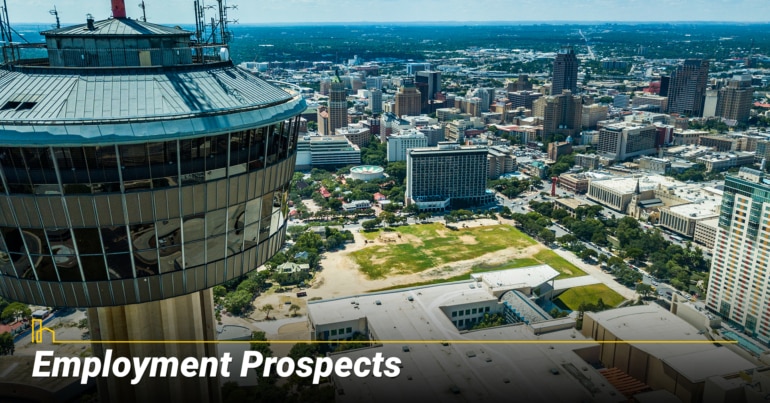
The unemployment rate in San Antonio is 3.9% (June 2021), which is above the U.S. national rate of 4.1% but below the Texas rate of 5.0%. The poverty rate, at 17.8%, is above the national average of 10.5% and the Texas average of 13.6%.
San Antonio is a large military hub; Joint Base San Antonio comprises Fort Sam Houston, Camp Bullis and the Lackland and Randolph Air Force Bases. The Northside Independent School District, one of the largest in the country, is a major employer. There are a number of large companies headquartered in the city, including H-E-B and USAA.
Given the hundreds of thousands of tourists that come to the city and region every year, leisure, tourism and hospitality workers are also abundant in San Antonio.
San Antonio residents have an average commute time of 24.7 minutes.
d. Unique Attributes and Lifestyle
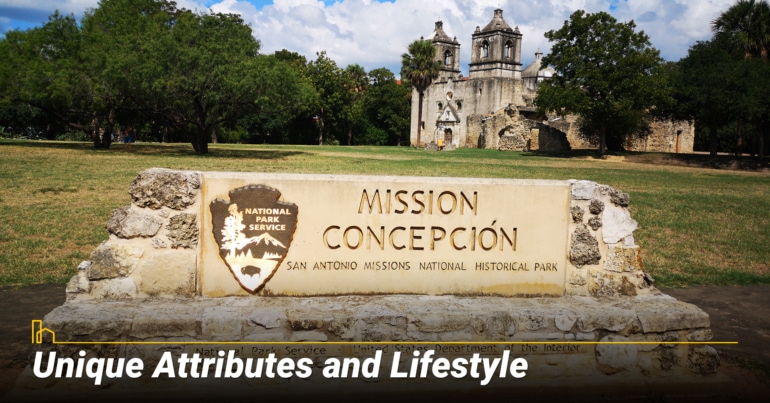
San Antonio is the best-known tourist destination in Texas. It is also a vibrant community with a large military base and a diverse population.
San Antonio welcomes visitors and tourists year-round. The city is home to the only UNESCO World Heritage site in Texas: San Antonio Missions National Historic Park, which includes the Alamo, the Rancho de las Cabras and four missions along the historic Mission Trail.
Known for being laid-back and a family town, San Antonio comes alive during traditional Mexican festivals. A prime spot for fine dining and music is the San Antonio River Walk, a 15-mile stretch along the Colorado River, which winds through downtown.
Some of San Antonio’s best-known tourist attractions include:
- The Alamo. Thirteen days of brave resistance at this converted mission spurred on the drive for Texas to gain independence from Mexico, making this a must-see site for visitors.
- The Mission Trail. The Mission Trail winds for nine miles southeast from the Alamo. Visitors enjoy the well-preserved sites of Nuestra Señora de la Concepción de Acuña, San Jose y San Miguel de Aguayo, San Juan Capistrano and San Francisco de la Espada.
- Family Fun. The San Antonio area features many family attractions that bring in hundreds of thousands of visitors a year — including Sea World, Six Flags and the Zoo — as well as river rafting or tubing along the Guadalupe River.
- Sports. The San Antonio Spurs, who have won five NBA championships in the past 20 years, are another premier draw in town.
e. Education
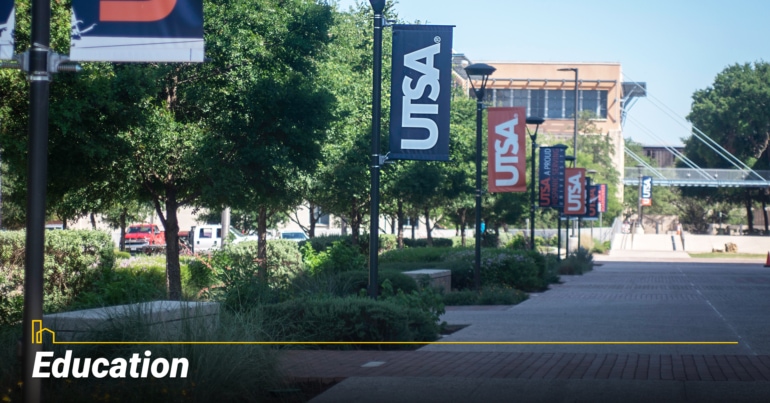
The University of Texas at San Antonio and Trinity College are the best-known institutions of higher education based in the San Antonio area.
The San Antonio Independent School District serves about 49,000 students across more than 90 schools. According to U.S. News & World Report, the San Antonio metro area has a total of 123 public and 105 private schools, and 66 of its high schools are ranked nationally.
Overall, San Antonio’s educational infrastructure is at or below par compared to similarly sized metro areas.
f. Healthcare and Safety
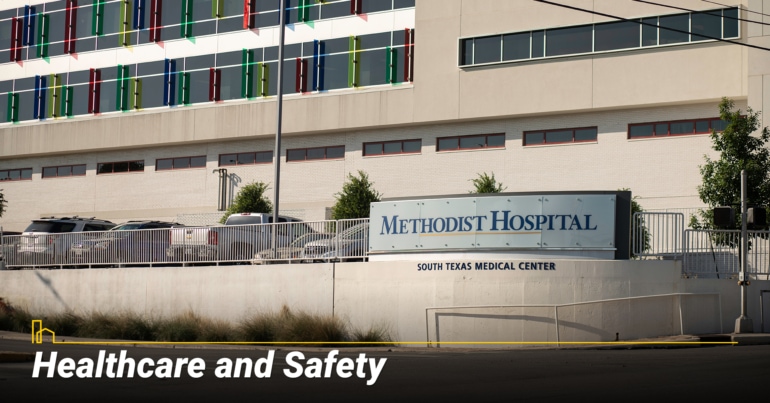
The top 3 hospitals in the San Antonio area are Methodist Hospital-San Antonio, Baptist Medical Center and University Hospital-San Antonio. The Brooke Army Medical Center is located within Fort Sam Houston to cater to army personnel and their families, among others.
San Antonio has 8.07 violent crimes per 1,000 residents, above Texas’s statewide median rate of 4.19 and the U.S. national median rate of 4.00. It has 43.77 property crimes per 1,000 residents, above Texas’s statewide median of 23.91 and the U.S. national median of 21.00.
What is It Like Living in Dallas Texas?
The city is the 9th largest in the United States. Dallas Texas is a little bit country, a little bit rock ’n’ roll, and a whole lot of history, arts, culture and business in the center of the fourth-largest metropolitan statistical area in the United…
Frequently Asked Questions (FAQs) When Living in Texas

A. Is everything really “bigger” in Texas?
If you’re asking a Texan, the answer will always be YES. Newcomers to the state will note that “Texas pride” is larger than life, with Texas flags flying along with the U.S. flag in many front yards. Sales pitches in everything from restaurant menus to grocery store ads will note items that are “Texas-sized.” Anecdotal observations aside, there are many ways in which Texas really is bigger than all or most of the other states in the U.S.
- a) Big geography: Texas is the second-largest state in the U.S. by land area.
- b) flags: Because Texas was an independent republic before becoming a state, its flag is actually allowed to fly alongside the U.S. flag. (Other states’ flags must be flown beneath the national flag.)
- c) Big sports: Texas A&M University has the largest football field in the SEC.
- d) Big religion: In Groom, Texas, there is a 190-foot freestanding Christian cross, the largest in the country.
- e) Big nature: Texas has 89 state parks and natural areas and two national parks. Big Bend National Park is the 15th largest in the U.S.
- f) Big skies: The International Dark-Sky Association designated the Big Bend Ranch State Park area in Southwest Texas as a “Dark Sky Park,” having one of the darkest and clearest views of the night sky in North America.
B. What is Tex-Mex?
“Tex-Mex” is a regional American food category specific to Texas. It is not the same as authentic Mexican cuisine, but it isn’t like classic American food either. It’s a type of food that is derived from the Tejano people–people of Spanish descent who lived in the Texas region before it was a republic.
Compared to traditional Mexican fare, Tex-Mex is usually spicier and cheesier, but there are still staple Mexican inclusions, such as avocados and tortillas. Tex-Mex favorites include fajitas, nachos and anything doused in melty yellow cheese (which you won’t find much in Mexico).
Typical Tex-Mex food is served with a variety of chips and dips, like queso (cheese dip), salsa verde (spicy green sauce), guacamole or creamy avocado ranch dip. Most “Mexican” restaurants in Texas serve Tex-Mex rather than authentic Mexican fare. Texans love their Tex-Mex, so be prepared for invites for fajitas and margaritas.
C. How is the barbecue?
Texans take their barbecue very seriously, and Texas barbecue is a style of its own. Famous for brisket and other pit-smoked meats, Texans are known for their “cowboy” style of cooking. Texas barbecue usually employs a direct-heat method, with meats cooked over mesquite more often than other types of wood.
The style draws its roots from the German and Czechoslovakian immigrants who came to the state in waves during the 19th century. There are scores of world-renowned barbecue festivals that take place around the state each year, most notably Texas Monthly’s Annual BBQ Fest in Austin.
D. What are state politics like?
Texas has traditionally been a conservative stronghold as far as U.S. politics are concerned, and in most of the smaller towns and cities around the state that is what you can expect. The stereotype is that Texans prioritize property rights, religious values, and guns, but the political landscape of the state is nuanced. Notably, the larger cities within the state almost always skew Democratic, and because of this, the political landscape of the state is leaning more “purple” in recent years.
Austin, San Antonio, Houston and Dallas were all “blue” in the last presidential election and have generally elected Democratic mayoral leadership. The vast swathes of rural areas of the country are generally Republican-leaning, but since they have a lower population than the bigger, more Democratic cities, the state is now considered “purple” overall. In fact, in the 2016 presidential election, Texas became a contested “battleground” state, though it did ultimately go red.
E. Is the state diverse?
Texas is the second most diverse state in the U.S.–a melting pot of culture and cuisine. It is predicted that by 2045, there won’t be a single ethnic majority in the state! Recent state demographics show that the state is 42.5% Caucasian, 39.3% Hispanic, 11.8% African American, 5.4% Asian, 0.3% American Indian, 0.1% Pacific Islander and 13.6% another ethnicity.
The diversity of the state has had a delicious effect on the food scene, especially in large cities where it is easy to find Vietnamese pho shops, Thai food, Mexican street food vendors, soul food and more. Thanks to diversity, the biggest cities in Texas are a foodie’s paradise.
F. Does everybody in Texas love football?
Sports lovers will note that Texans love their football games! Whether it’s college, pro or even high school football, sports fans in the Lone Star State are plentiful. Even non-enthusiasts find themselves enjoying the camaraderie of the football culture, as “tailgating” turns the average sports outing into a social event.
Tailgating involves packing up a cooler full of ice-cold beverages and snacks— along with a barbecue grill—into the bed of a truck, which is then stuffed with friends and family on their way to a football stadium parking lot. In the lot, fans return to the truck bed for refreshments, food and social hour.
Bars have taken note of tailgating culture, advertising their establishments on game days as de facto tailgating locations where you need not be troubled with the packing or cooking. These places will often bring in local cook teams who prepare tailgating favorites like burgers and barbecue under an outdoor tent and serve them to patrons inside the bar while they watch their favorite game on the big-screen TVs.
CONCLUSION
As the descriptions above show, Texas has something to offer every person who would like to visit or live there: history, art, culture, entertainment, food, sports and a distinctive touch of the Old West. The population has been growing younger and more multicultural with every passing year, a trend that’s likely not only to continue but to grow stronger.
If you like big-city living, with all its amenities and comfort, but would like to have access to wide-open spaces on a regular basis, most of these Texas cities will appeal to you.
If, however, you want to escape the hustle and bustle of large metropolitan areas, Texas offers a plethora of small towns and semi-urban hideaways for you. We will review some of those in Part II of this series.
The 10 Most Affordable Places to Live in California in 2024
We assessed the cost of living across Californian cities and compared them to the national average. The cost of living is calculated based on 5 main categories: housing, food, healthcare, transportation and energy. Based on these calculations, we narrowed down the list to California’s 10 most affordable cities…





